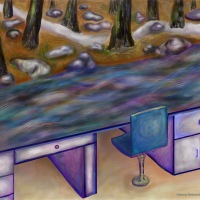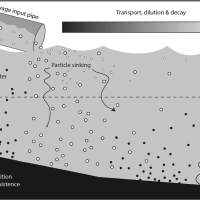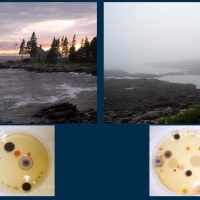Using Microbiological Techniques to Monitor Water and Air Quality in Urban and Rural Landscapes
In the realm of scientific research, the health of our environment often serves as the proverbial canary in the coal mine, providing essential cues to larger issues at hand. In this context, water and air quality monitoring is paramount. These twin pillars of environmental health influence various phenomena, ranging from human well-being to climate dynamics and ecological balance within microbiology. Modern techniques to monitor water and air quality are used to ensure the best outcomes, and editors for students are using this information in their works.
Microbiological Techniques for Water Quality Monitoring
-
Indicator Organisms
One of the earliest microbiological techniques used in water quality monitoring is the detection of indicator organisms. These organisms, like E. coli and Enterococci, are typically non-pathogenic, but their presence in water signifies possible fecal contamination and the potential existence of disease-causing pathogens. Monitoring their populations can predict the risk of waterborne disease outbreaks.
For example, public health departments regularly check recreational water sites for these indicator organisms in many parts of the world. One example is the U.S. Environmental Protection Agency's Beaches Environmental Assessment and Coastal Health Act of 2000, which mandates regular monitoring of E. coli and Enterococci in coastal recreational waters.
-
Polymerase Chain Reaction (PCR)
The Polymerase Chain Reaction (PCR) allows scientists to detect specific genetic markers of potential pathogens, providing a more direct measure of water safety. In PCR, a small sample of water is sufficient to amplify trace amounts of DNA from target organisms, rendering it a powerful tool in early detection and source tracking of contamination.
An example of this in action is the identification of Cryptosporidium in drinking water. Cryptosporidium, a protozoan parasite, can cause severe diarrheal disease in humans. With PCR, water treatment facilities can quickly detect its presence and take immediate action to prevent an outbreak.
-
Next-Generation Sequencing (NGS)
This technology can sequence millions of DNA fragments simultaneously, providing a snapshot of the entire microbial ecosystem in water rather than a select few indicator organisms. NGS has been widely used to investigate the microbiota of diverse water systems, from pristine natural springs to heavily polluted industrial outlets.
Microbiological Techniques for Air Quality Monitoring
-
Bioaerosol Sampling
Like water, air quality can also be monitored using microbiological techniques. Bioaerosol sampling, for example, captures airborne particles containing microorganisms, enabling us to assess the diversity and abundance of microbial life in the air. Current practices involve using devices such as impingers, impactors, and cyclones, each catering to specific aspects of bioaerosol research.
In healthcare facilities, bioaerosol sampling is critical in preventing nosocomial infections. For instance, monitoring air quality in operating rooms can provide an early warning of potential airborne pathogens, facilitating timely intervention.
-
Culture-Based Methods
Culture-based methods are a traditional approach to air quality monitoring. Here, the bioaerosols collected are cultured on a suitable medium to grow and identify specific microbes.
An example of culture-based methods is the routine monitoring of Legionella spp. in building ventilation systems. Regular air sampling followed by culture can effectively prevent outbreaks of Legionnaires' disease.
-
Metagenomic Analysis
The emerging field of metagenomics, where genetic material is directly sampled from environmental sources, is reshaping our understanding of air quality.
A recent example of metagenomic analysis applied to air quality monitoring is the study of bioaerosols in subway systems, like the PathoMap project in New York. This project revealed a rich microbial diversity, including benign and potentially pathogenic microbes, providing a new perspective on public health in densely populated urban areas.
Applications of Microbiological Techniques in Urban Landscapes
In a nutshell, microbiological techniques form the backbone of modern environmental monitoring across urban and rural landscapes. They offer a lens through which it is possible to view the invisible world of microorganisms, turning this knowledge into actions that preserve our environment and promote human health. As the field continues to evolve, scientists anticipate an exciting future where microbiological monitoring plays an ever more pivotal role in maintaining the delicate balance of our planet.
-
Monitoring Drinking Water Sources
In bustling urban environments, ensuring drinking water quality is of utmost importance. Microbiological techniques come into play here, providing vital data to guide water treatment procedures. For instance, PCR and NGS are often combined to detect and identify harmful pathogens in reservoirs or groundwater sources.
In cities like Copenhagen, where a significant proportion of drinking water comes from groundwater, these techniques ensure the safety of water at the source, complementing traditional treatment methods.
-
Wastewater Treatment Plants
Wastewater treatment plants are another crucial application area. They serve as gatekeepers, preventing harmful substances from entering natural water bodies. In these settings, microbial analysis plays a dual role: assessing the efficacy of the treatment process and monitoring the potential environmental impact of effluents.
A recent application can be seen in monitoring SARS-CoV-2 RNA in wastewater treatment plants. This innovative approach has enabled early detection of COVID-19 in urban communities, showcasing microbiology's adaptive role in public health.
-
Recreational Water Bodies
Urban recreational water bodies, like swimming pools and man-made lakes, are hotspots for potential microbial contamination. Regular monitoring using techniques like culture-based methods and PCR can help maintain a safe and healthy environment for the public. For instance, cities like Toronto routinely monitor public beaches for E. coli, a key indicator organism, during the summer swimming season.
Applications of Microbiological Techniques in Rural Landscapes
-
Agricultural Runoff
In rural landscapes, agricultural runoff is a major source of water contamination. Pesticides, fertilizers, and manure can introduce many microorganisms into nearby water bodies. Microbiological techniques are used to monitor these changes, providing crucial information to devise strategies for sustainable farming.
For instance, in rural communities, PCR techniques have been applied to trace the source of nutrient pollution in local waterways, allowing for more targeted interventions to reduce agricultural runoff.
-
Livestock Farming
Livestock farming contributes significantly to air and water pollution in rural areas. Microbiological monitoring, including bioaerosol sampling and metagenomic analysis, can help manage this impact. This data can guide farm management practices, enhancing animal health while preserving environmental quality.
One application of this is the monitoring of antibiotic-resistant bacteria in livestock farms. Using microbiological techniques, researchers can track the spread of these bacteria, informing policies on antibiotic use in agriculture.
-
Natural Water Sources
Natural water sources in rural areas, like lakes, rivers, and springs, serve as key indicators of regional environmental health. Microbial monitoring of these sources using techniques like NGS offers a snapshot of the entire microbial ecosystem, illuminating any shifts due to human activities or natural changes.
An exciting example is the use of microbiological techniques to monitor the health of freshwater sources in rural Alaska. These methods have provided critical insights into the impact of climate change on these vital ecosystems.
Challenges and Limitations of Microbiological Techniques in Environmental Monitoring
While microbiological techniques have revolutionized our understanding of environmental health, it's important to acknowledge that they are not without challenges and limitations. These hurdles, varying from sampling variability to cost and time constraints, must be navigated effectively for successful environmental monitoring.
-
Sampling Variability
The accuracy of microbiological analyses largely depends on the samples collected, making sampling variability a significant challenge. In water and air quality monitoring, this variability can stem from multiple factors like temporal fluctuations, geographical differences, and changes in environmental conditions.
-
Data Interpretation
While being a boon, the wealth of data generated by advanced microbiological techniques, such as NGS and metagenomics, can also pose challenges in data interpretation. Given the vast diversity of microbial life, understanding the significance of a particular microbial profile can be complex.
-
Cost and Time Constraints
Microbiological techniques can be expensive and time-consuming, particularly the more advanced ones. Not all institutions or regions have access to the necessary resources, which can limit their application.
While the potential of microbiological techniques in environmental monitoring is vast, overcoming these challenges is crucial for their successful application. As we advance, the symbiotic relationship between science and technology will help us surmount these hurdles, leveraging microbiological techniques to their fullest potential in safeguarding our environment.
Future Directions in Microbiological Monitoring
As we traverse the environmental health landscape, microbiological monitoring is becoming increasingly central. Advancements in technology and computational biology are pushing the boundaries of our understanding, unveiling new dimensions of microbiological dynamics. The future promises to be an exciting blend of technological innovation, integrative methodologies, and novel applications.
-
Automation and Miniaturization
In the pursuit of real-time monitoring and higher sampling frequency, automated and miniaturized systems for microbiological monitoring are under development. These devices, such as autonomous water sampling robots and portable microbial samplers for air quality monitoring, can significantly reduce human intervention, allow remote access, and increase sampling efficiency.
-
Harnessing the Power of AI and Big Data
The explosion of data generated by modern microbiological techniques like NGS and metagenomics calls for advanced data interpretation tools. Artificial Intelligence (AI) and machine learning algorithms offer exciting possibilities. They can help uncover hidden patterns, predict microbial community responses to environmental changes, and enable real-time decision-making based on complex microbiological data.
In addition, big data analytics could foster global collaboration and data sharing in microbiological monitoring. By pooling data from various regions and ecosystems, we could better understand global environmental health.
-
Monitoring for Climate Change Mitigation
As the world grapples with the challenge of climate change, microbiological monitoring can play a pivotal role in our response. For instance, monitoring microbial communities in soils and oceans could help us understand and enhance their roles as carbon sinks. Similarly, monitoring methane-producing microbes in agriculture and waste management could guide strategies to reduce greenhouse gas emissions.
The future of microbiological monitoring is teeming with possibilities. As we venture deeper into this microscopic world, the insights garnered will be vital in guiding our efforts toward a sustainable future.
Many microorganisms shape environmental health, influencing everything from the purity of drinking water in cityscapes to managing agricultural runoff in rural settings. An exploration of water and air quality monitoring necessitates a deep dive into the complex workings of microbiological techniques, their multifaceted applications across urban and rural landscapes, and the enduring challenges they face. Can these techniques arm us adequately to combat the future potential threat? As we stand on this precipice of discovery and innovation, microbiological monitoring remains a captivating enigma, teeming with potential yet to be unlocked.







